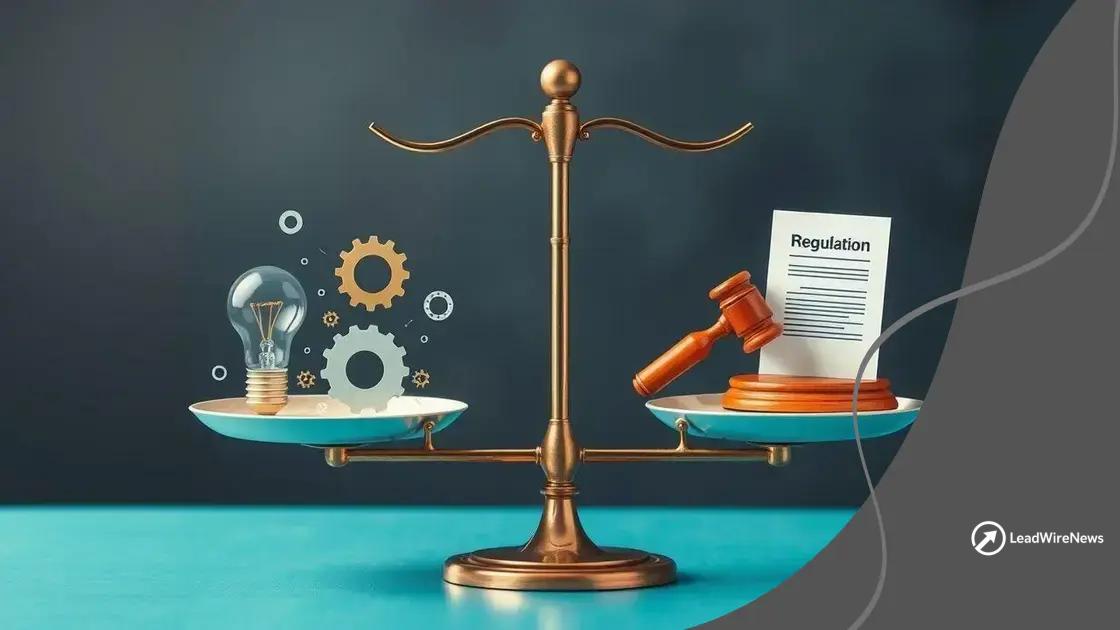Developments in the regulation of artificial intelligence

Anúncios
Developments in the regulation of artificial intelligence are crucial for balancing innovation and safety, focusing on ethical guidelines, global cooperation, and adapting to technological advancements while addressing challenges like compliance and enforcement.
Developments in the regulation of artificial intelligence are shaping how we interact with technology daily. Have you ever wondered how these regulations could impact your life and the future of innovation?
Anúncios
Current landscape of AI regulation
The current landscape of AI regulation is rapidly evolving and increasingly significant. With advancements in technology, countries are responding with frameworks to ensure safety, ethical standards, and accountability.
Key Drivers of AI Regulation
Several factors motivate national governments to focus on regulating AI technologies:
- The need for public safety and ethical considerations.
- Addressing job displacement due to automation.
- Protecting consumer rights and privacy.
- Fostering innovation while managing risks.
Different regions are adopting unique approaches to AI regulation. For instance, the European Union aims for comprehensive legislation, while the United States approaches it more fragmentarily. These varied perspectives influence both local industries and global markets.
Anúncios
International Cooperation
Regulatory bodies are recognizing the importance of collaboration to tackle cross-border technological challenges. International cooperation may enhance standardization in AI practices, making it easier to navigate legal landscapes.
As countries develop their policies, there’s an ongoing discussion about balancing innovation with regulation. Striking this balance is crucial for maintaining competitive advantages while ensuring that AI benefits society as a whole.
International perspectives on AI governance
When discussing international perspectives on AI governance, it becomes clear that different countries see the challenges and opportunities in artificial intelligence in unique ways. Each nation is developing its own regulations, balancing technology with ethics and public interest.
Regional Approaches
Countries such as China, the United States, and members of the European Union are setting the stage for global standards in AI:
- China focuses on rapid AI development while maintaining governmental control over technologies.
- The United States tends to support innovation with fewer restrictions, promoting a free-market approach.
- The European Union is pursuing comprehensive regulations to protect individuals and enhance accountability.
These diverse approaches can lead to both opportunities and challenges in international collaboration. For example, while different regulatory frameworks exist, the need for a common ground becomes essential for cross-border AI applications.
Global Organizations’ Role
Organizations like the OECD and UNESCO are playing vital roles in shaping AI governance on a global scale. They are working to create guidelines that promote ethical AI development while encouraging member countries to collaborate and share best practices.
By understanding these international perspectives, nations can work together more effectively. Balancing innovation and regulation is vital as AI continues to transform societies worldwide.
Impacts of regulation on innovation

The impacts of regulation on innovation in artificial intelligence are significant and multifaceted. Regulations can either foster growth or create barriers, depending on how they are designed and implemented.
Positive Impacts of Regulation
Effective regulations can lead to innovation in several ways:
- They establish safety standards that build public trust in AI technologies.
- Clear guidelines encourage businesses to invest in new AI solutions.
- They can promote competition by ensuring that all companies adhere to the same rules.
Moreover, regulations that protect consumer rights can spur innovation as companies look for ways to meet these demands. When businesses know they must adhere to specific standards, they often find creative solutions to comply while still meeting consumer needs.
Potential Drawbacks
On the other hand, overly strict regulations could stifle innovation. If the compliance costs are too high, smaller businesses might struggle to compete, leading to a less dynamic market. Excessive red tape can also delay product releases, making it harder to keep pace with rapidly evolving technology.
Maintaining a balance is critical. Policymakers must create frameworks that enable innovation while ensuring safety and ethics. This balance allows for a vibrant landscape where new ideas can thrive.
Challenges in enforcing AI laws
The challenges in enforcing AI laws are significant and complex. As technology evolves, so do the ways in which it can be used and misused. Ensuring compliance with laws regarding artificial intelligence is not straightforward.
Ambiguity in Regulations
One major challenge is the ambiguity in regulations. Many laws are still in development, and existing laws may not be specific enough to address AI-related issues. This vagueness can lead to confusion among companies trying to comply.
- Companies might face legal risks if they misinterpret unclear regulations.
- Varying laws across jurisdictions can complicate compliance for international companies.
- Lack of standardized definitions of AI can lead to inconsistent enforcement.
Another issue is the rapid pace of AI development. Technology evolves faster than regulations can be created or updated. This creates gaps where harmful practices might arise without adequate legal frameworks to address them.
Resource Limitations
Enforcement agencies often face resource limitations. They may lack the technical knowledge and tools needed to monitor AI technologies effectively. Training personnel to understand complex AI systems can be costly and time-consuming.
This lack of resources can lead to inconsistent enforcement and challenges in holding companies accountable. As AI technology becomes more integrated into everyday life, the need for skilled regulators will also increase.
Future trends in AI regulation
The future trends in AI regulation are becoming increasingly important as technology advances. As artificial intelligence continues to evolve, regulatory frameworks must adapt to meet new challenges and opportunities.
Emphasis on Ethical Standards
One key trend is the growing emphasis on ethical standards. Governments and organizations are focusing on ensuring that AI systems align with ethical practices. This includes protecting user privacy and preventing bias in algorithms.
- Developments in ethics can guide AI design and deployment.
- Public demand for transparency will push companies to adopt clearer practices.
- As awareness increases, ethical guidelines can lead to public trust in AI technologies.
Another trend involves the collaboration between governments and tech companies. Engaging the tech industry in the regulatory process can help create practical and effective regulations. By working together, they can develop rules that encourage innovation while ensuring safety.
Global Cooperation and Standardization
As AI technology transcends borders, there will be a greater need for global cooperation. Countries must work together to create standardized regulations that apply internationally. This will help mitigate issues arising from differing laws in various regions.
Furthermore, regulations that are consistent across countries can facilitate smoother operations for international businesses. Companies will have a clearer understanding of the rules they must follow, which can drive innovation without compromising safety.
In conclusion, the future of artificial intelligence regulation holds promise but also presents challenges. As technology advances, it’s vital for regulations to keep pace. Balancing innovation with safety is crucial for harnessing AI’s full potential. Collaboration between businesses and governments can lead to effective frameworks. By establishing ethical standards and fostering global cooperation, we can ensure that AI benefits society as a whole.
FAQ – Frequently Asked Questions about AI Regulation
What are the key challenges in AI regulation?
Key challenges include ambiguity in regulations, rapid technological advancements, and resource limitations for enforcement agencies.
How can businesses prepare for future AI regulations?
Businesses can stay informed about regulatory developments, invest in compliance training, and collaborate with policymakers to influence effective regulations.
What role do ethical standards play in AI regulations?
Ethical standards are crucial as they guide the development and implementation of AI technologies, ensuring they are used responsibly and fairly.
How can global cooperation improve AI regulation?
Global cooperation can lead to standardized regulations, making it easier for businesses to operate internationally while ensuring consistent protections across borders.